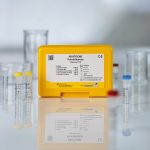Intended use:
For in vitro diagnostic use. RIDA®GENE Parasitic Stool Panel I is a multiplex real-time PCR assay for the direct, qualitative detection and differentiation of Giardia lamblia, Cryptosporidium spp., Entamoeba histolytica and Dientamoeba fragilis in human stool samples.
RIDA®GENE Parasitic Stool Panel I multiplex real-time PCR is intended for use as an aid in diagnosis of gastrointestinal infection caused by parasites.
General information:
Giardia lamblia, Cryptosporidium spp. and Entamoeba histolytica and Dientamoeba fragilis are the most important diarrhea-causing protozoa.
Giardia lamblia (synonym G. intestinalis or G. duodenales) is one of the most important causes of diarrhea. According to the CDC (Center for Disease Control) about 2 % of all adults and 6 – 8 % of all children in developed countries and about a third of all people in developing countries are infected with giardiasis. The CDC estimates about 77,000 cases of giardiasis each year in the U.S.. Infection with G. lamblia occurs by ingestion of cysts in contaminated food, drinking water or by faecal-oral route from person to person. The incubation time is between 1 to 3 weeks. The symptoms of giardiasis (lambliasis) are acute or chronic diarrhea, but asymptomatic cyst elimination is also occurring. Acute symptoms include watery diarrhea, loss of appetite, nausea, abdominal cramps and weight loss.
Cryptosporidium parvum is one of several species of the genus Cryptosporidium. Besides C. parvum, also C. hominis most commonly causes cryptosporidiosis in humans. However, also infections by other Cryptosporidium spp. such as C. felis, C. meleagridis, C. canis, and C. muris may lead to clinical symptoms. Cryptosporidiosis was detected in up to 0.2 % of healthy individuals and about 2 % of patients with diarrhea in developed countries. In developing countries the prevalence elevated up to 9 %. In HIV patients with diarrhea Cryptosporidium spp. was detect up to 14 – 24 % while up to 5 % of asymptomatic HIV patients were infected. During an outbreak in Milwaukee, USA in 1993 over 400,000 individuals were sickened. Each year estimated 748,000 cases of cryptosporidiosis occur in the United States. The infection occurs after the ingestion of oocysts in contaminated water and food, as well as by faecal-oral route from person to person. In immunocompetent persons the disease manifests itself after 2 to 10 days as a self-limiting watery diarrhea and may be accompanied by nausea, abdominal pain and weight loss. Immunocompromised individuals often develop serious, chronic, and sometimes fatal illness.
Entamoeba histolytica is the only human pathogenic species of the genus Entamoeba and the causative agent of amoebiasis. Infection with E. histolytica occurs by ingestion of cysts in contaminated food, drinking water or by faecal-oral route from person to person. Most of the E. histolytica infections manifest as asymptomatic colonization. In 10 % of the cases the infection leads to amoebic colitis and on rare occasions to extraintestinal amoebiasis, mostly to the liver (amebic liver abscess). Clinical symptoms associated with intestinal amoebiasis are stomach pain and severe diarrhea with bloody and slimy stools. The WHO estimates that about 50 million people worldwide suffer from amoebiasis each year, resulting in 100,000 deaths each year.
Dientamoeba fragilis has a worldwide distribution and recent studies demonstrated the pathogenic potential and implicated it as a common cause of gastrointestinal disease. Infection with D. fragilis may be either symptomatic or asymptomatic. Symptoms of dientamoebiasis are abdominal pain and diarrhea. The prevalence of D. fragilis varies from 0.3 % to 52 % and often exceeds that of Giardia lamblia.
Classically, diagnosis of G. lamblia, Cryptosporidium spp., Entamoeba spp. and Dientamoeba fragilis is achieved by microscopical examination of fecal samples, which require experienced personal. RIDA®GENE Parasitic Stool Panel I multiplex real-time PCR assay is a new and attractive alternative method for testing stool samples and has proven to be highly sensitive and specific for the simultaneous detection of the three most important diarrhea causing parasites (Giarida lamblia, Cryptosporidium spp., Entamoeba histolytica and Dientamoeba fragilis).
| Art. No. | PG1715 |
|---|---|
| Test format | real-time PCR with 100 reactions |
| Shelf life | 24 months after production |
| Sensitivity | Analytical sensitivity: ≥ 50 DNA copies per reaction |
Dear customers,
we have started to provide the documents for our products in an electronic format. These are the Instructions for Use (IFU), the Safety Data Sheets (SDS) and the Certificate of Analysis (CoA). For batches placed on the market after 01 January 2023, you can find our documents on the eIFU portal eifu.r-biopharm.com.










